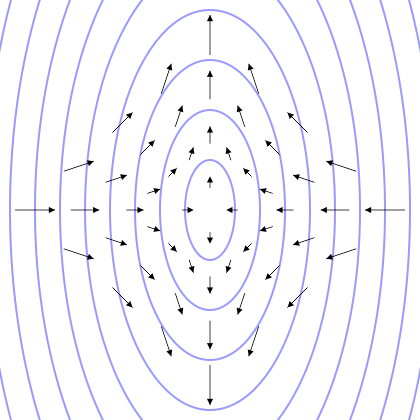
Linearly polarised gravitational wave
On September 14, 2015, the LIGO Scientific Collaboration observed gravitational waves from a 410 megaparsec (1.3 billion light years) distant merger of two black holes. Previously, gravitational waves had only been inferred only indirectly, via their effect on the timing of pulsars in binary star systems. It was also the first observation of a binary black hole merger, demonstrating both the existence of binary stellar-mass black hole systens, and the fact that such mergers could occur within the current age of the universe.
Einstein’s Prediction
In 1916, Albert Einstein [4] already predicted the existence of gravitational waves in his famous general theory of relativity. Gravitational waves are so called ripples in the curvature of spacetime that propagate as waves, generated in certain gravitational interactions that propagate outward from their source.
Laser Interferometer Gravitational Wave Observatory (LIGO)
Back then, Einstein’s calculations demonstrated that massive accelerating objects would disrupt space-time and that ‘waves’ of distorted space would radiate from the source. These waves – ripples – would then travel through the Universe at the speed of light carrying information about their cataclysmic origins, as well as invaluable clues to the nature of gravity itself. According to the Laser Interferometer Gravitational Wave Observatory (LIGO), the supposedly strongest gravitational waves are produced by events like for instance colliding black holes, supernovae, coalescing neutron stars or white dwarf stars, the slightly wobbly rotation of neutron stars that are not perfect spheres, and the remnants of gravitational radiation created by the birth of the Universe itself.
First Evidence
In 1974, unfortunately 20 years after the death of famous Albert Einstein, the first proof of the existence of gravitational waves was found. At the Arecibo Radio Observatory in Puerto Rico,[5] a binary pulsar was discovered which – according to the theory – were supposed to radiate gravitational waves. Back then, scientists began to test Einstein’s theory and started measuring how the period of the stars’ orbits changed over time. Eight years later, they found out that both stars approached each other with the rate previously predicted by the theory of general relativity. As the system has been monitored for over 40 years and the observed changes in the orbit agree so well with general relativity, there is no doubt that it is emitting gravitational waves.
Timing of Pulsar Radio Emissions
In the meantime, a number of astronomers have studied the timing of pulsar radio emissions and found similar effects, further confirming the existence of gravitational waves. However, until 2015, gravitational waves had only been confirmed through calculations and not actually through a physical contact.
The Sensational Discovery
On September 14, 2015, LIGO first sensed distortions in spacetime itself caused by passing gravitational waves generated by two colliding black holes nearly 1.3 billion light years away. By the time, the gravitational waves from the first detection reached LIGO, the amount of space-time wobbling they generated was thousands of times smaller than the nucleus of an atom. The discovery is considered as one of the greatest human scientific achievements.
Harnack Lecture | Rainer Weiss “Gravitational Wave Astrophysics” [7]
References and Further Reading:
- [1] Gravitational Waves at LIGO
- [2] Gravitational Waves at the Scientific American
- [3] Gravitational Waves at the nature Journal
- [4] How Albert Einstein Revolutionized Physics, SciHi Blog
- [5] The Arecibo Radio Telescope – Looking for Extraterrestrial Signals, SciHi Blog
- [6] Gravitational Waves at Wikidata
- [7] Harnack Lecture | Rainer Weiss “Gravitational Wave Astrophysics”, Max Planck Society @ youtube
- [8] Collins, Harry, Gravity’s Shadow: The Search for Gravitational Waves, University of Chicago Press, 2004.
- [9] Collins, Harry, Gravity’s Kiss: The Detection of Gravitational Waves (The MIT Press, Cambridge Massachusetts, 2017).
- [10] Timeline of Gravitational Wave Research, via Wikidata and DBpedia





